Featured image courtesy USL; others, PSP archives
In two measurable ways and beyond any possible dispute by its fiercest critic, Bethlehem Steel is better in 2017 than in the previous year.
Santi Moar’s game-winner in Ottawa (above right) is the perfect illustration as new acquisition scored a game-winner on the road.
With eleven games to play, the Steel have already earned 33 points – five more than they gained throughout the entire 2016 season. And this season, the Steel notched the same number of road wins as home wins, which was not the case last year, as the Steel only won twice away from home. One of those victories was the season opener.
How has it happened?
- First, they have better players.
- Second, several individual players have clearly improved in the first half of the 2017 season.
- And third, the front office has done a much better job of building a roster that can succeed within the limits imposed by league rules and organization budgets (the Steel’s roster is comprised of thirteen players).
Consider each of these three points in more detail.
Comparing players
(Editor’s note: Goalkeepers completely skipped Tim’s mind. A thoughtful reader asked the obvious question. We have added Tim’s response. Aug. 17, 8:30 AM)
Goalkeepers: In 2016 four keepers played for the Steel. One, a Union loanee, appeared twice to tune up for upcoming Union starts. A second, also a loanee, started all the games in the first several weeks of the season and led the defense, gelling it, as befitted a former USL keeper of the year.
The third, rostered to the Steel, played decently but with a few key game-losing mistakes, realized he had no shot at the first team, and asked to leave. The fourth, a stopgap from the semi-pros, finished out the season.
In 2017 no goalkeepers are rostered to the Steel. The bulk of the minutes have gone to the Union’s number 3, quite strong at USL level who is benefitting from the time. A couple of tune-ups have gone to the Union’s number 2.
The Academy’s best, a 16-year-old eligible for El Salvador’s youth national teams where he starts, has gotten six starts and has grown in confidence and success. He seems a solid investment in the future as he learns from his experiences.
Flank backs: In 2016 both starting Steel flank backs, effective defenders, were dependent on combination play to generate offense. And there was no real depth behind them.
While their four 2017 replacements can all combine, three of them can attack their markers individually one versus one. And the fourth has displayed vision at least as good as the best 2016 player.
Center backs: In 2016, the position had no depth at all. When replacements were necessary, defensively oriented midfielders were moved to the back line and replaced in the midfield.
The 2017 side had three such players, not two, thanks to an academy senior who could step in seamlessly for the homegrown player who earned call-ups to his youth national team side. And, as a soccer-playing unit if not quite yet as individual physical specimens, the three are, at times, more effective together than the first-team loanees who come down in those spots.
Double pivot: Last year’s double pivot was tall, athletic and dominant in the air. They destroyed attacks by winning balls, but initiating offense was not their strong suit.
This year’s double pivot is not aerially dominant as they win balls more through intelligent positioning than physical strength. However, they has done a much better of job launching attacks.
Last year’s defense gave up forty-three goals. But with eleven games left to play, the Steel has only conceded twenty-five. That is about one quarter of a goal less per game and 17% fewer than last season, so far.
Flank mids: 2016’s flank mids were effective defenders. They were not especially good at attacking their markers with individual technical skill as they relied more on speed and strength. The service delivered into the central channel was not especially effective, and they scored few goals themselves.
In 2017, the technical skill deficit has been rectified, including the twinkle-toes quotient. So have been the team’s goals-scored totals. Last year, the Steel scored 32 goals in 30 games, while being shut out nine times. This year so far, the Steel has only been shut out four times while scoring 27 goals in 21 games. That’s a 17% improvement and better offensive flank midfield play is a big reason why.
Attacking center mid: In 2016, the Steel did not have effective ones aside from their versatile Irish fireplug. Union players loaned down to play there failed to produce and other experiments from within the roster were only marginally successful.
This year the Steel’s own roster has two flank mids who would have started inside at the number 10 last season on merit, a Spaniard and a Canadian.
But the season’s best has been a Union loanee acquired from New York Red Bulls in the offseason for a draft pick. Interestingly enough, he had a true break-out performance against Red Bulls II.
And the organization’s recent homegrown “pre-signing” also can play attacking mid. He is very clean on the ball but as yet a bit tentative creatively.
Striker: The three strikers from 2016 are the three strikers in 2017, and the 2016 very young, deep reserve player remains the young, deep reserve who has added flank mid to his repretoire.
The 2016 backup came to preseason better prepared physically to confront the USL’s athletic challenges, and he came back with a much improved mentality. He won the starting job in preseason and is the team’s leading scorer. But, he is currently recovering from an injury and is searching for his earlier form.
The 2016 starter has become a very offensive-minded starting flank midfielder – a position he plays for his national team – who hasn’t scored many goals, but whose energy and work rate on both sides of the ball are essential to the team success being explained in this article.
At striker, the names are the same both years, but their productivity is much, much different. And better.
Individual improvements
For roster holdovers, the point of comparison is last October, while for additions, it’s this past February. And we address only clear, major standouts.
Seku Conneh’s transformation occurred in the offseason.
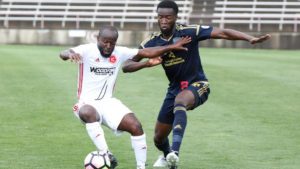
Seku Conneh contests the ball 7/1/17
Coach Burke had so fully absorbed the present reality of his transformed player that, when asked to identify noteworthy improvement around the season’s halfway point, he had to be reminded of the striker’s production last October. He corrected the omission.

Matt Real at Goodman Stadium
Matt Real first came to the coach’s mind, and recent matches have illustrated his point. In February, he appeared to be an injured, deep-reserve development project. In July, he has stepped ahead of Charlie Reymann into Gili Wijnaldum’s departed cleats at left back. Charlie himself is a full quantum level ahead of last year’s fixed incumbent.
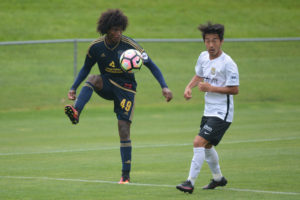
Yosef Samuel against Charleston 5/6/17
The coach accepted PSP’s inclusion of Yosef Samuel in the list, echoing assistant coach Jay Cooney’s earlier observation that his offensive decision-making needs improvement. But coach’s February questions about defending responsibly have transmuted into a statement made three separate times now that his coach trusts Yosef to defend. And these days that defensive energy substitution occurs in the middle as well as on the flank.
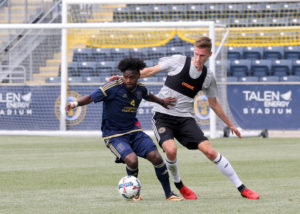
Chris Nanco v Jack Elliott at Talen 3/25/17
And Chris Nanco has gone from not necessarily making the roster in the earliest parts of preseason, to a consistent part of the lineup, to the week 20 USL Team of the Week, to scoring both a goal and an assist two games in a row.
Three other names deserve mention in PSP’s opinion, in addition to its formal chat with the coach – one of which is an attacker while the other two are defenders.
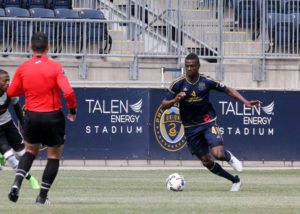
Cory Burke at Talen 3/25/17
While maintaining his relentlessly predatory attitude towards opposing defenders, Cory Burke has improved his individual offensive ball control and is a more effective holdup player because of it, whether on the flank or in the center. He can be in better positions to distribute off the dribble as well.
In 2016, a season hampered by some injuries, Mark McKenzie showed he had tremendous potential as a defender.

Mark McKenzie defends Jay Simpson 3/25/2017
This year it wasn’t just potential, it was production. In one tantalizingly suggestive game, he and Auston Trusty played center back together, shutting down a dangerously pacey mid-table attacking side.
Finally, Matt Mahoney has stepped in seamlessly when needed in two defensive positions – center back for Hugh Roberts and right back for Aaron Jones.

Matt Mahoney, right, defends at Goodman 7/15/17
.
That seamlessness did not exist last February in preseason scrimmages, and Mahoney’s recent key passes were nowhere.
Roster building: Background
We infer a better job of building the roster is a reason for the Steel’s improvement from last season.
Not only is the roster much better, its flexibility in dealing with unexpected challenges is much better.
There may well be greater confidence among the staff that they can take younger players of strong character and good potential and teach them to do what is needed, instead of bringing in veterans. The organization is learning what it can do, during its on-going, multi-year upgrade from Union 1.0 to Union 2.0.
Whenever PSP has witnessed the Sporting Director offering observations on the players he has just watched, Coach Burke is locked into him like a mother fox with a den full of kits tracking an unwary field mouse. The coach has stated that Earnie Stewart is a tremendous resource for information.
Roster building: A guess
By July 2016, whom to invite to continue beyond October as the “scout” practice team for the Academy U-18s had been decided. We assume Academy Director Tommy Wilson and his staff, coach Burke and his staff, and Mr. Stewart made those decisions.
Those decisions meant that somebody – mostly Burke and his assistants from things he has said – had begun scouting NCAA players’ summer soccer (PDL) and the USL itself looking for candidates to fill identified needs.
Probably, Burke invested the most time in thinking about how the Steel needed to be in 2017 and after discussions with his staff, he made his recommendations to the sporting director and others.
Hugh Roberts, Santi Moar, Chris Nanco, Matt Mahoney, Charlie Reymann, and probably Chris Wingate are the collective result.
Pressure creates diamonds
It is an article of faith among classroom teachers that the second time a course is taught is the time of greatest improvement.
Certainly, the second season of the Steel has seen a lot of improvement. Significant further opportunity does lie ahead, and that future will be challenging for the rest of the season. It starts tonight on the road against first place Charlotte, and continues Sunday against second place Louisville at home.
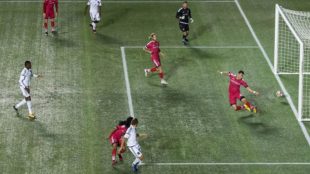

Comments